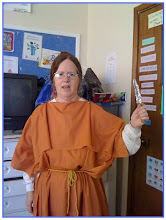Anthony Gibbins has written a companion story to CLC Bk I, the first four stages, using most of the same vocabulary but using different characters and a new plot. Here are the episodes along with the material from CLC they match up with:
http://tarheelreader.org/2009/08/09/gilbo-chapter-one/
(CLC pp. 3-5, familia)
http://tarheelreader.org/2009/08/10/gilbo-chapter-two/
(Cerberus, p. 6)
http://tarheelreader.org/2009/08/10/gilbo-chapter-3/
(amicus, pp. 16-17)
http://tarheelreader.org/2009/08/11/gilbo-chapter-4/
(Metella, pp. 18-19)
http://tarheelreader.org/2009/08/12/gilbo-chapter-5/
(mercator, p. 20)
http://tarheelreader.org/2009/08/14/gilbo-chapter-6/
(mercator, p. 20)
http://tarheelreader.org/2009/08/23/gilbo-chapter-7/
(in triclinion, p. 20)
http://tarheelreader.org/2009/08/23/gilbo-chapter-8/
(in foro, p. 28)
http://tarheelreader.org/2009/08/24/gilbo-chapter-9/
(pictor, p. 29)
http://tarheelreader.org/2009/08/25/gilbo-chapter-10/
(pictor, p. 29)
http://tarheelreader.org/2009/08/26/gilbo-chapter-11/
(tonsor, p. 30)
http://tarheelreader.org/2009/08/26/gilbo-chapter-12/
(venalicius, p. 31)
http://tarheelreader.org/2009/09/01/gilbo-chapter-13/
(venalicius, p. 31)
http://tarheelreader.org/2009/09/04/gilbo-chapter-14/
(venalicius, p. 31)
http://tarheelreader.org/2009/09/08/gilbo-chapter-15/
(Hermogenes, p. 43)
Sunday, 18 October 2009
Cambridge mini-books with complete text
salvete omnes!
I am now adding versions of the stories which have the complete sentence and distinguish the two versions by calling the complete one (textus) and the one with blanks (lacunae). Laura Gibbs explains how to write multiple versions of the same Tarheel Reader here:
http://libellilatini.blogspot.com/2009/05/how-to-create-reader.html
Here are the dual versions of Verba I:
http://tarheelreader.org/2009/10/18/verba-i-textus/
and
http://tarheelreader.org/2009/10/16/verba-i/
(I'm still working on why the word "lacunae" isn't in the URL ...)
Here's Verba II:
http://tarheelreader.org/2009/10/18/verba-ii-textus/
and with gaps:
http://tarheelreader.org/2009/10/05/verba-ii/
Verba III:
http://tarheelreader.org/2009/10/18/verba-iii-textus/
and with gaps:
http://tarheelreader.org/2009/10/12/verba-iii/
I am now adding versions of the stories which have the complete sentence and distinguish the two versions by calling the complete one (textus) and the one with blanks (lacunae). Laura Gibbs explains how to write multiple versions of the same Tarheel Reader here:
http://libellilatini.blogspot.com/2009/05/how-to-create-reader.html
Here are the dual versions of Verba I:
http://tarheelreader.org/2009/10/18/verba-i-textus/
and
http://tarheelreader.org/2009/10/16/verba-i/
(I'm still working on why the word "lacunae" isn't in the URL ...)
Here's Verba II:
http://tarheelreader.org/2009/10/18/verba-ii-textus/
and with gaps:
http://tarheelreader.org/2009/10/05/verba-ii/
Verba III:
http://tarheelreader.org/2009/10/18/verba-iii-textus/
and with gaps:
http://tarheelreader.org/2009/10/12/verba-iii/
Thursday, 15 October 2009
Tarheel Readers for Cambridge
salvete omnes! I have been creating a few little books at tarheelreader.org to review vocabulary from Cambridge Latin Course, Bk I. (I was greatly inspired by Anthony Gibbins' Gilbo series on Tarheel; thanks, Anthony!) Here are the relevant books I have created so far:
http://tarheelreader.org/2009/08/26/caecilia-et-porca/
"Caecilia et porca" can be read almost immediately by beginning students.
The exciting sequel:
http://tarheelreader.org/2009/09/13/ubi-est-caecilia/
This ties in with the rooms of the house and is also extremely elementary.
http://tarheelreader.org/2009/10/16/verba-i/
This is a fill-in-the-blanks Latin vocabulary exercise for CLC Stage 1. I have added the word "filia" at the request of my all-girl classes!
http://tarheelreader.org/2009/10/05/verba-ii/
This is a fill-in-the-blank Latin exercise based on the vocabulary of Ch. 2.
http://tarheelreader.org/2009/10/12/verba-iii/
Same thing for Ch. 3.
Here is a little book to go with Ch. 4, giving some examples of first and second person singular:
http://tarheelreader.org/2009/10/20/ego-et-tu/
This is a set of question words (cur, ubi, etc.) and examples of questions using them.
http://tarheelreader.org/2009/10/31/quaestiones/
I'll keep updating as I create more minibooks.
My very first blog ... I must think of more things to add.
Ann Martin
http://tarheelreader.org/2009/08/26/caecilia-et-porca/
"Caecilia et porca" can be read almost immediately by beginning students.
The exciting sequel:
http://tarheelreader.org/2009/09/13/ubi-est-caecilia/
This ties in with the rooms of the house and is also extremely elementary.
http://tarheelreader.org/2009/10/16/verba-i/
This is a fill-in-the-blanks Latin vocabulary exercise for CLC Stage 1. I have added the word "filia" at the request of my all-girl classes!
http://tarheelreader.org/2009/10/05/verba-ii/
This is a fill-in-the-blank Latin exercise based on the vocabulary of Ch. 2.
http://tarheelreader.org/2009/10/12/verba-iii/
Same thing for Ch. 3.
Here is a little book to go with Ch. 4, giving some examples of first and second person singular:
http://tarheelreader.org/2009/10/20/ego-et-tu/
This is a set of question words (cur, ubi, etc.) and examples of questions using them.
http://tarheelreader.org/2009/10/31/quaestiones/
I'll keep updating as I create more minibooks.
My very first blog ... I must think of more things to add.
Ann Martin
Labels:
Cambridge,
elementary,
Latin,
tarheel reader,
vocabulary
Subscribe to:
Posts (Atom)
